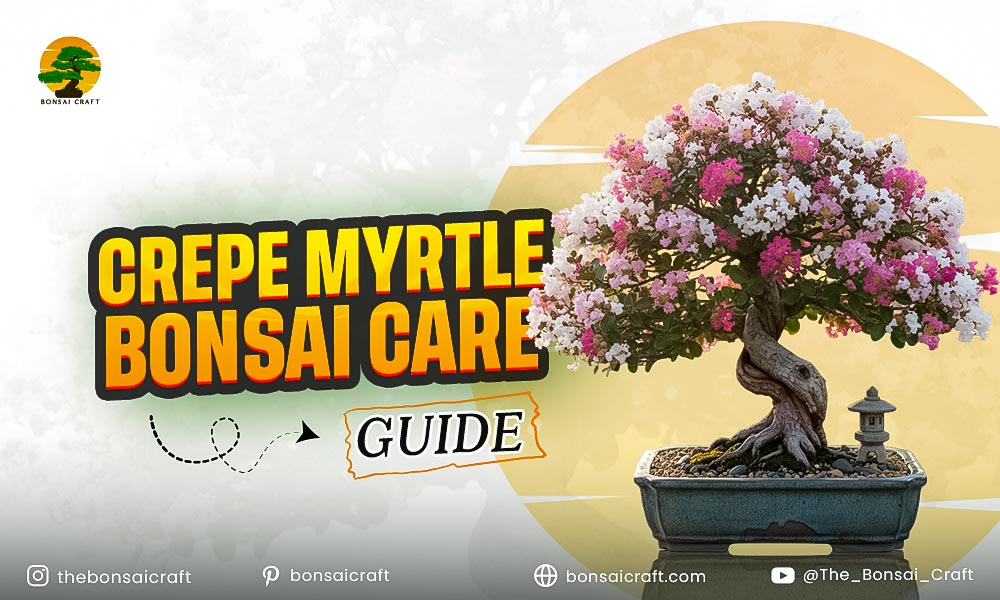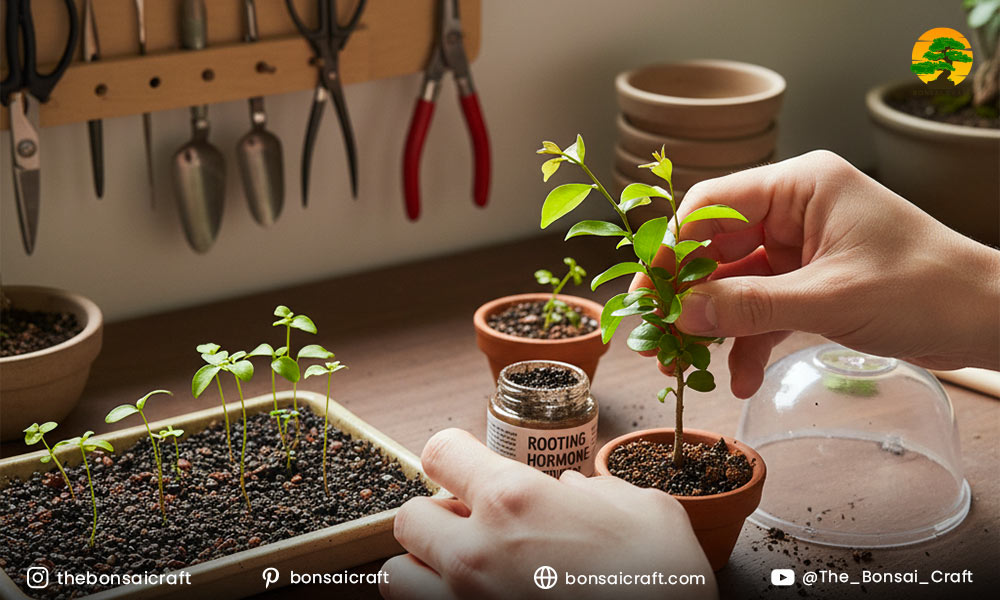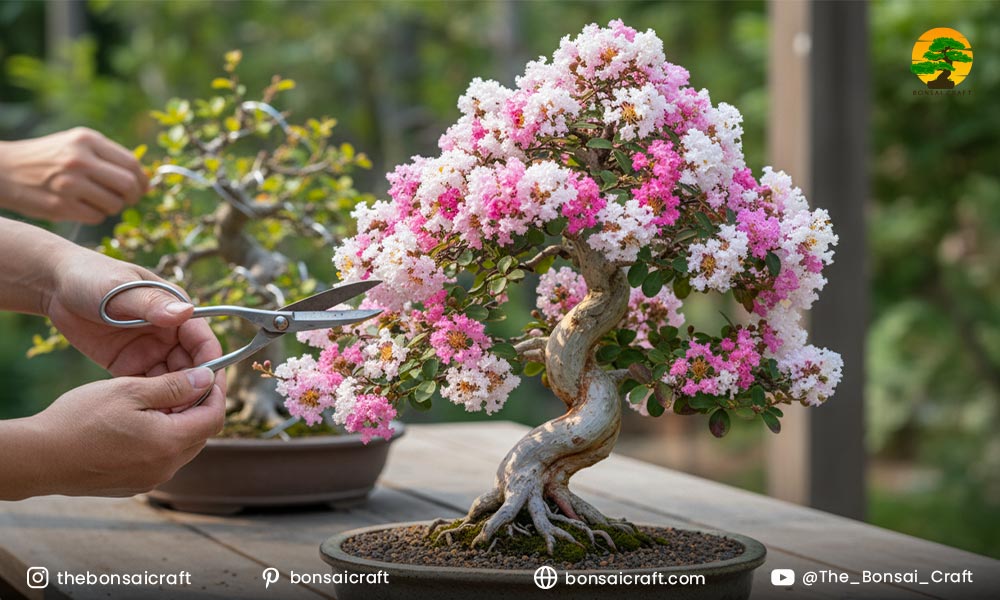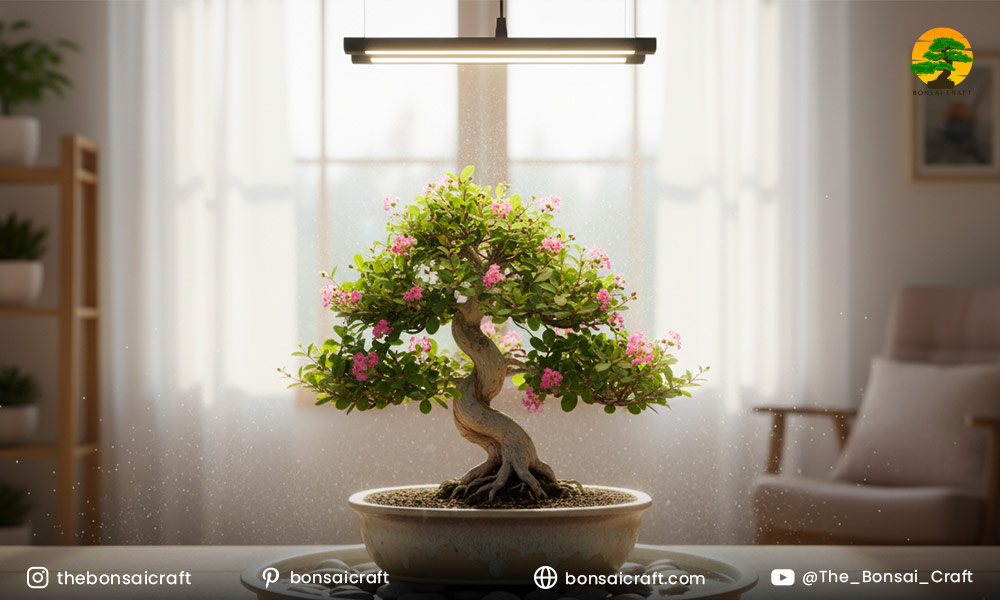
The crepe myrtle bonsai (Lagerstroemia indica) is a stunning blend of vibrant flowers, smooth bark, and graceful branching. Perfect for both beginners and experienced bonsai enthusiasts, this species thrives with proper care and attention. Whether you aim to grow a bonsai crepe myrtle from seed, cutting, or maintain a mature crepe myrtle bonsai tree, understanding its unique growth patterns and styling potential is essential.
With over a decade of personal experience cultivating crepe myrtle bonsai, I provide this detailed guide on crepe myrtle bonsai care, offering actionable tips and professional insights to help your bonsai flourish year-round.
Why Grow a Crepe Myrtle Bonsai Tree?
The crepe myrtle bonsai tree is admired for:
- Vibrant blooms: Ranging from pink, purple, red, to white, lasting several weeks.
- Distinctive bark: Smooth and exfoliating, providing year-round aesthetic appeal.
- Compact growth habit: Easily trained for various bonsai styles.
- Seasonal beauty: Attractive leaves, bark, and flowers through all seasons.
A bonsai crepe myrtle offers both visual beauty and a rewarding cultivation experience, combining ornamental value with manageable growth.

How to Bonsai a Crepe Myrtle: From Seed and Cuttings
You can create a crepe myrtle bonsai from seed or cuttings. Seeds require scarification and moist, well-draining soil to germinate, while cuttings root faster and produce strong initial growth, ideal for beginners or early styling.
Growing from Seed:
- Slightly sand the hardened coat to scarify the seeds.
- Soak the seeds in warm water for 24 hours.
- Keep the planting temperature between 65- 75° F, and the bonsai soil mix.
- Germination takes 2-3 weeks and the seedlings can be transplanted after they reach a height of 3- 4 inches.
Growing from Cuttings:
- Take cuttings from semi-hardwood stems in late spring.
- For better success rates, dip the rooting hormone.
- The plant should be moistened, and the soil should be draped with a humidity dome.
- After 3-5 weeks, the plant should be transplanted and the roots should be stable.
Cuttings generally offer faster establishment and stronger early growth for bonsai crepe myrtle training.
Best Soil and Pot for Crepe Myrtle Bonsai
The ideal soil for crepe myrtle bonsai care is a well-draining mix of akadama, pumice, and lava rock. Use shallow bonsai pots with drainage holes to ensure healthy root development and prevent waterlogging.
Details:
- Well-draining soil supports aeration and moisture retention.
- Shallow bonsai pots encourage root ramification, essential for miniature proportions.
- Slightly acidic to neutral soil promotes flowering.

Crepe Myrtle Bonsai Pruning Techniques
Pruning maintains shape, encourages flowering, and manages the size of a bonsai crepe myrtle.
Structural Pruning: Remove dead, weak, or crossing branches in late winter before growth begins.
Maintenance Pruning: Summer pruning reduces leaf size, encourages flowering, and maintains branch structure.
Pinching: Regularly pinch back new shoots to promote ramification and dense foliage.
Wiring Tips:
- Use soft aluminum wire during spring when branches are flexible.
- Avoid wiring too tightly to prevent bark scarring.
- Remove the wire after 2–3 months to prevent damage.
How Often Should I Water a Crepe Myrtle Bonsai?
Water your crepe myrtle bonsai tree when the top 1–2 inches of soil feels dry. During hot summers or flowering periods, daily watering may be required, while reduced watering is sufficient in winter. Avoid overwatering to prevent root rot.
Watering Tips:
- Summer: Maintain consistent moisture for active growth and flowers.
- Winter: Reduce watering as trees enter dormancy.
- Indoor bonsai: Use misting and pebble trays to maintain humidity.
Fertilizing a Crepe Myrtle Bonsai
Proper fertilization is key to healthy growth and vibrant blooms:
- Apply balanced liquid fertilizer (NPK 10-10-10) every 2 weeks in spring and summer.
- Use phosphorus-rich fertilizer in early spring to stimulate flowering.
- Avoid excessive nitrogen, which encourages leaf growth over flowers.
Seasonal Care for Crepe Myrtle Bonsai
- Spring: Structural pruning, repotting, and fertilization.
- Summer: Water regularly, pinch new shoots, and enjoy flowering.
- Autumn: Reduce feeding and prepare for dormancy while enjoying autumn colors.
- Winter: Protect from frost and maintain minimum moisture levels for indoor crepe myrtle bonsai.
Repotting a Crepe Myrtle Bonsai
For younger trees, repotting every 2 – 3 years is encouraged while for mature specimens, it is every 3 – 4 years. This should be done in early spring before the onset of growth. Bonsai trees’ root systems should be trimmed by a third, the soil should be changed to bonsai soil, and the substrate should be replenished to promote healthy growth.
Steps:
- Gently lift the bonsai from its pot.
- Remove any thick and circling roots.
- Add new soil, making sure it has good drainage.
- If the tree needs it, secure it to the pot with bonsai wire.
- Water extensively, do not fertilize for 4 – 6 weeks.

Indoor Crepe Myrtle Bonsai Care Tips
While bonsai crepe myrtle prefers outdoor conditions, indoor cultivation is possible with attention:
- Provide 6–8 hours of bright, indirect sunlight or use grow lights.
- Maintain humidity with pebble trays or regular misting.
- Rotate the tree regularly to ensure balanced growth.
- Avoid drafty or extremely dry conditions.
Indoor bonsai may produce fewer blooms but remain attractive and healthy with proper care.
Advanced Styling Techniques for Crepe Myrtle Bonsai
- Flower-focused pruning: Selective pruning enhances flower cluster density.
- Deadwood techniques: Expose portions of the trunk for character.
- Cascade and semi-cascade styles: Ideal for display on tables or shelves.
- Multi-trunk (clump) style: Groups of stems from one base mimic natural clusters.
- Root-over-rock style: Creates dramatic, visually appealing bonsai displays.
Pest and Disease Management
Common pests:
- Aphids and spider mites – damage leaves and buds.
- Scale insects – affect sap and growth.
- Powdery mildew – fungal growth on foliage.
Management:
- Use neem oil or insecticidal soap for pests.
- Ensure proper airflow to reduce fungal problems.
- Inspect trees weekly during active growth.
Conclusion
The crepe myrtle bonsai is a versatile and rewarding species, offering vibrant flowers, attractive bark, and flexible growth for bonsai enthusiasts. Whether you cultivate a crepe myrtle bonsai from seed or cuttings, proper attention to pruning, watering, fertilization, and seasonal care ensures your tree thrives and blooms year after year.
My expert tip: Beginners should start with cuttings for faster results and early styling opportunities. With consistent crepe myrtle bonsai care, your bonsai will become a captivating centerpiece in your collection.
FAQs About Crepe Myrtle Bonsai
How do I start a bonsai crepe myrtle from seed?
Scarify the seeds, soak them for 24 hours, and place them into loose, well-draining soil. Keep moderately warm and moist, and within 2-3 weeks, germination should occur. This technique offers the most control during the development cycle of your bonsai crepe myrtle.
Can I make a crepe myrtle bonsai from cuttings?
Certainly, semi-hardwood cuttings root more quickly and produce stronger growth, which makes them perfectly suitable for the initial development stages of bonsai training.
How often should I prune my crepe myrtle bonsai?
Do more precise pruning in the late winter, and more general pruning during the summer. New blooming shoots should be pinched back to encourage thicker flowering and denser leaves.
Is it possible to keep a crepe myrtle bonsai indoors?
Yes, although it will require more light and humidity, the bonsai may bloom less than the ones kept outside, but it will still look very pretty.
How often should I repot a crepe myrtle bonsai tree?
Repot every 2–3 years for young trees, 3–4 years for mature trees. Early spring is best, with root trimming and soil refresh for continued health.
